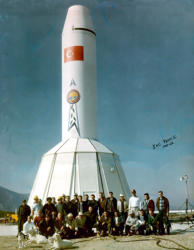HISTORY - Page 49
Besides serving as the thrust agent for the missile, propellants were also important in missile control. For
example, the thrust unit effected roll control by deflecting the exhaust gases from the turbine and
swiveling the turbine exhaust nozzle. A second unit was the vernier thrust system that was mounted on
the aft section of the body to provide fine control of cutoff velocity of the body immediately after
separation from the thrust unit. This was accomplished by a solid propellant unit rated at 500 pounds of
thrust and capable of operating for 20 seconds. While the missile was out of the sensible atmosphere and
had already separated from its thrust unit, eight jet nozzles equally spaced on the missile body provided
pitch, yaw, and roll. These jets were off-on types, and were powered by nitrogen from storage bottles
housed in the body. This formed the spatial attitude control system.
To depict the operation of the propulsion system during a typical flight, the missile was launched vertically
and then was tilted gradually by a guidance program device into a ballistic trajectory. Trajectory was
divided into four major phases: main power, vernier, spatial attitude control, and re-entry. While in the
main power phase, the missile was controlled in pitch and yaw by hydraulically activated swiveling of the
rocket engine, and in roll by the thrust unit roll control system. Separation of the body and thrust unit
then occurred when the main rocket engine cut off, and then the missile was in its vernier phase. The
vernier engine now operated to control missile velocity along the trajectory until the slant range computer
in the G&C was satisfied. All during this time, the spatial attitude nozzles were helping maintain control,
_____________________________










Jupiter SM-78 Weapon System
I&C Team 2, Çigli AB, Turkey 1961-1962 Chrysler Corporation Missile Division

HISTORY - Page 49
Besides serving as the thrust agent for the missile,
propellants were also important in missile control. For
example, the thrust unit effected roll control by
deflecting the exhaust gases from the turbine and
swiveling the turbine exhaust nozzle. A second unit
was the vernier thrust system that was mounted on
the aft section of the body to provide fine control of
cutoff velocity of the body immediately after
separation from the thrust unit. This was
accomplished by a solid propellant unit rated at 500
pounds of thrust and capable of operating for 20
seconds. While the missile was out of the sensible
atmosphere and had already separated from its
thrust unit, eight jet nozzles equally spaced on the
missile body provided pitch, yaw, and roll. These jets
were off-on types, and were powered by nitrogen from
storage bottles housed in the body. This formed the
spatial attitude control system.
To depict the operation of the propulsion system
during a typical flight, the missile was launched
vertically and then was tilted gradually by a guidance
program device into a ballistic trajectory. Trajectory
was divided into four major phases: main power,
vernier, spatial attitude control, and re-entry. While in
the main power phase, the missile was controlled in
pitch and yaw by hydraulically activated swiveling of
the rocket engine, and in roll by the thrust unit roll
control system. Separation of the body and thrust unit
then occurred when the main rocket engine cut off,
and then the missile was in its vernier phase. The
vernier engine now operated to control missile
velocity along the trajectory until the slant range
computer in the G&C was satisfied. All during this
time, the spatial attitude nozzles were helping
maintain control,
_____________________________





















